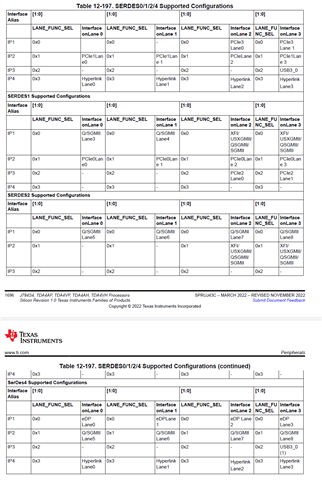Other Parts Discussed in Thread: SYSCONFIG
Tool/software:
Hello,
I have two questions related to CPSW9G configuration and syscfg.
1. Within SPRSP79B under Table4-1, it mentions that:
PORT1 Signals: SGMII1, Modes: One of 5Gb, 10Gb USXGMII/XFI, 2.5 Gb SGMII/XAUI, 1Gb SGMII, 5Gb QSGMII
PORT2 Signals: SGMII2, Modes: One of 5Gb, 10Gb USXGMII/XFI, 2.5 Gb SGMII/XAUI, 1Gb SGMII, 5Gb QSGMII
PORTn (n=3 thru 8) Signals: SGMIIn, Modes: One of 2.5 Gb SGMII/XAUI, 1Gb SGMII, 5Gb QSGMII
If QSGMII is used on any SGMII Port 1 thru 4, then SGMII1/2/3/4 cannot be used for Ethernet functionality since all 4 internal CPSW
ports map to the selected QSGMII SERDES port
The J784s4 syscfg file within the SDK only enables SGMII7 and SGMII8. This matches the schematic for the J784s4.
We have used ENET-EXP-2 for USXGMII, which is either SGMII7/8. However according to SPRSP79B isn’t USXGMII compatible.
In examples in the SDK, MAC_PORT_2 is used for USXGMII. Does SGMII7 not equate to MAC_PORT_7 in the SDK?
Please can you clarify how SGMIIn relates to MAC_PORT_n?
2. We are trying to configure our board using syscfg. Why when we use syscfg 1.20, and modifying the enet_cpsw9g configuration, the data configuration file is not updated as it does with other peripherals?



